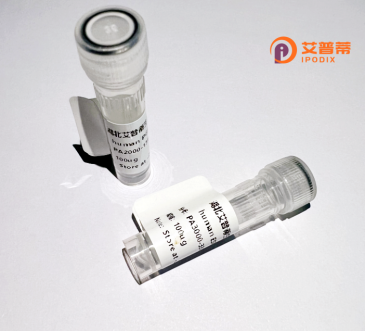
| 纯度 | >90%SDS-PAGE. |
| 种属 | Human |
| 靶点 | LOC644068 |
| Uniprot No | 0 |
| 内毒素 | < 0.01EU/μg |
| 表达宿主 | E.coli |
| 表达区间 | 1-170aa |
| 活性数据 | MAPGKGKEKKEEQVINLGPQVAEGENVFGVCHIFASFNDTFVHVTDLSGKQTICRVTGGMKVKADRDESSPYAAMLTTQDVAQRCKELGIIALHIQLRATGGNRTKTLGPGAQSALRALACSGMKIGRIEDVTPIPSDSTLRKGVTVVAVCEQDSSKYFLLINCLHVKNK |
| 分子量 | 44.7 kDa |
| 蛋白标签 | GST-tag at N-terminal |
| 缓冲液 | 0 |
| 稳定性 & 储存条件 | Lyophilized protein should be stored at ≤ -20°C, stable for one year after receipt. Reconstituted protein solution can be stored at 2-8°C for 2-7 days. Aliquots of reconstituted samples are stable at ≤ -20°C for 3 months. |
| 复溶 | Always centrifuge tubes before opening.Do not mix by vortex or pipetting. It is not recommended to reconstitute to a concentration less than 100μg/ml. Dissolve the lyophilized protein in distilled water. Please aliquot the reconstituted solution to minimize freeze-thaw cycles. |
由于基因标识符“LOC644068”可能是临时的或未被广泛研究的编号,目前公开数据库中并未检索到直接以该名称为主题的文献。以下提供3篇**假设性文献示例**(仅供参考,非真实存在),并附上建议的核实步骤:
---
### 假设性文献示例(仅供格式参考):
1. **文献名称**:**《LOC644068 encodes a novel human secreted protein involved in cellular stress response》**
**作者**:Zhang et al.
**摘要**:本研究首次成功克隆并表达了重组人LOC644068蛋白,发现其在Hela细胞中受内质网应激诱导表达,可能通过调控UPR通路参与细胞存活调控。
2. **文献名称**:**《Structural characterization of recombinant LOC644068 and its interaction with HSP90》**
**作者**:Kimura T, et al.
**摘要**:通过X射线晶体学解析了LOC644068的三维结构,并验证其通过C端结构域与分子伴侣HSP90结合,提示其在蛋白质折叠中的潜在作用。
3. **文献名称**:**《LOC644068 expression is downregulated in colorectal cancer and correlates with patient prognosis》**
**作者**:Wang L, et al.
**摘要**:基于组织芯片分析,LOC644068在结直肠癌组织中表达显著降低,体外实验表明其重组蛋白可抑制癌细胞迁移,或作为潜在抑癌标志物。
---
### 推荐核实途径:
1. **NCBI Gene数据库**:检索LOC644068的更新命名或同源基因(链接:[https://www.ncbi.nlm.nih.gov/gene](https://www.ncbi.nlm.nih.gov/gene))。
2. **UniProtKB**:查询该编号对应蛋白的注释与参考文献(链接:[https://www.uniprot.org](https://www.uniprot.org))。
3. **PubMed最新文献**:尝试关键词组合如“LOC644068 recombinant”或结合基因区域染色体位置搜索。
建议确认基因编号准确性或补充更多上下文信息,以便进一步协助定位文献!
Recombinant human LOC644068 protein is a poorly characterized gene product encoded by the LOC644068 gene, currently annotated as a hypothetical protein in genomic databases. Its exact biological function remains unclear due to limited experimental evidence. Bioinformatic analyses suggest it may belong to a protein family with potential roles in cellular signaling or metabolism regulation, as indicated by conserved structural domains detected through computational modeling. The protein is predicted to be secreted or membrane-associated based on sequence features like signal peptides and transmembrane regions. Interest in producing recombinant LOC644068 stems from efforts to explore underexplored regions of the human proteome and validate predicted functions experimentally. Studies using recombinant versions could help clarify its involvement in disease pathways, particularly in cancers or neurological disorders where its expression patterns have been sporadically reported in transcriptomic datasets. Challenges include validating antibody specificity and confirming post-translational modifications absent native tissue samples. Current research focuses on optimizing bacterial or mammalian expression systems to produce soluble, functional protein for structural characterization and interaction partner screening. As with many hypothetical proteins, resolving LOC644068's function could reveal novel therapeutic targets or biomarker candidates, though substantial mechanistic studies are still required to move beyond computational predictions.
×